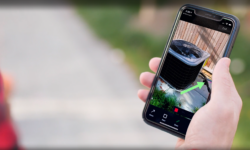Z-Wave’s New ‘SmartStart’ Feature Simplifies Smart Home Setup
Z-Wave SmartStart enables the pre-configuration of devices to a network before they reach the home, reducing installation time and maximizing ROI for installers.

A new Z-Wave feature developed by Sigma Designs called SmartStart will make it easier than ever to enroll smart devices into a home automation system for instant interoperability and control.
August, the popular maker of automated door locks and smart doorbells, is the first adopter with its new Z-Wave-enabled Smart Lock Pro.
How much easier can it possibly be to add Z-Wave devices to a smart home system? Today, all you have to do is press a button to provision a Z-Wave product. The only question is: which button do you press, how many times, and for how long?
Simple enough. Just check the instruction manual.
Say it’s a GE light switch. You would be directed to tap the upper paddle, and then “press here” in the app, and the switch is good to go.
Moving to your Leviton dimmer, press and hold the top paddle for 7 seconds until the LED blinks amber. Then tap the paddle once more.
To pair your Honeywell thermostat, press and hold the middle tab on the bottom row until the menu changes.
For a Kwikset lock, press button “A” on the back panel of the lock interior once.
To register a Fibaro sensor, open the battery compartment and press the interior button three times in rapid succession. Pat your head. Rub your belly. And whistle the theme to The Andy Griffith Show.
When you consider a house full of disparate Z-Wave devices in different categories from different manufacturers, the process can be pretty unnerving. It’s not like you can just take your collection of goodies, sit on the couch and enroll them all at once while watching “Judge Judy.” They need to be powered up first. SmartStart fixes that.
The real drag is you might not know the manufacturer of a particular product, like an already-installed light switch, a smart bulb or a sensor. What then? SmartStart fixes that, too.
Folks don’t tend to keep light-bulb instruction manuals these days, and there’s not some big database in the sky that details the pairing methods for every Z-Wave device (although SmartThings does a really good job of it). With SmartStart, you don’t need it.
By the way, this pairing process isn’t unique to Z-Wave. The same annoyance applies to Bluetooth and ZigBee, as well.
Auto-Enrollment with SmartStart
Say goodbye to the tedious enrollment process with the new SmartStart feature, a creation of Z-Wave technology developer Sigma Designs.
There’s no guessing how to register a SmartStart product. Each has a unique QR code on the device itself, as well as the packaging.
Whatever Z-Wave hub (“gateway”) you’re working with, simply open the app for that system and scan the QR codes of the products to be paired. These wunderthings automatically go where they’re supposed to go within the app – lights over here, locks over there, everything in its place ….
“It eliminates all the variations in how you add and subtract devices from a Z-Wave system,” says Avi Rosenthal, principal of IoT Consulting, LLC.
The beauty is that devices don’t need to be powered up to enroll in the system, which means pairing can be done at the factory, distributor’s warehouse, dealer’s office, in the house, with a mouse ….
When the system arrives at a customer premises, Rosenthal explains, “They plug in the gateway, power up the devices, and everything’s synced. The user doesn’t have to do anything.”
So, backing up: If the factory or distributor or dealer or other third party is doing the provisioning offsite, they’re not actually dropping the devices into an app. They’re simply storing them in their rightful places in the cloud or the hub itself. When the hub and devices are powered up, the user’s app fetches all the data and the system is ready to go.
Rosenthal recalls his days with a manufacturer of Z-Wave environmental controls serving the hospitality industry. The company provided pre-provisioned lights and thermostats for thousands of hotel rooms to be installed by electricians. A guy at the factory sat there powering up each device one by one, pressing and holding the appropriate buttons to pair each product with a controller, and then repackaging each unit.
With SmartStart, just put the boxes in a row, snap a few images and … done!
How SmartStart Works
To enable the SmartStart service, Sigma created a new Z-Wave gateway software layer which resides in a product’s firmware.
A Device Specific Key (DSK) unique to each device is coded into the device when it is manufactured. Manufacturers will have to track serialized products, which might be a new adventure for some IoT companies, but the end result will be worth it in terms of more products sold, says Mitch Klein, executive director of the Z-Wave Alliance.
The 16 byte DSK is half of a security key used to authenticate the device only when it is being added to the network.
The DSK must be printed on the device. If the device is small, only a unique identifying number (PIN code) may be printed on the device, “but the full DSK in either numeric or QR Code format must be placed elsewhere (in the packaging) so that the entire DSK is available if needed,” Klein says.
For a controller/gateway to be SmartStart-enabled, it will support the ability to read product information via QR Code, or otherwise grab a provisioning list that was built elsewhere.
“The provisioning list is what guides the controller to know that it may automatically enroll and configure the Z-Wave devices,” Klein says.
SmartStart isn’t mandatory for Z-Wave certification, but Klein expects widespread adoption by hub and device manufacturers.
At the same time, the Z-Wave Alliance is standardizing the provisioning methods for device classes so, for example, all Z-Wave dimmers from any manufacturer might be enrolled into a system by tapping the top paddle twice.
At the end of the day, Z-Wave systems will be simpler for both end users and integrators to install and configure.
Editor’s Note: The following story first ran in Security Sales & Integration’s sister publication CE Pro.
If you enjoyed this article and want to receive more valuable industry content like this, click here to sign up for our FREE digital newsletters!

Security Is Our Business, Too
For professionals who recommend, buy and install all types of electronic security equipment, a free subscription to Commercial Integrator + Security Sales & Integration is like having a consultant on call. You’ll find an ideal balance of technology and business coverage, with installation tips and techniques for products and updates on how to add to your bottom line.
A FREE subscription to the top resource for security and integration industry will prove to be invaluable.








